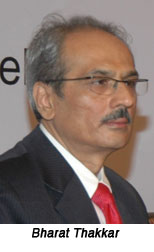 By
now everybody is aware, having learned from IATA and others who have
been reading the tea leaves and following trends, that the short-term
outlook for the air cargo industry is bleak. By
now everybody is aware, having learned from IATA and others who have
been reading the tea leaves and following trends, that the short-term
outlook for the air cargo industry is bleak.
The Eurozone crisis, for example, has
started having an impact the world over, and India is no exception.
 In
India, air cargo stakeholders echoed the dim prospects. Bharat J. Thakkar,
President, Air Cargo Agents Association of India, pointed out that 2011
had been an eventful year. In
India, air cargo stakeholders echoed the dim prospects. Bharat J. Thakkar,
President, Air Cargo Agents Association of India, pointed out that 2011
had been an eventful year.
“The freight forwarding community
weathered the storm of recession in 2009 and 2010 and recovered—to
an extent—in the first quarter of 2011,” he said. However,
the good times did not last. Thakkar said, “Before we could breathe
easy, the industry was pushed to the back foot. All through the year,
our customers have had to encounter increases in transaction costs over
the rise in the price of air turbine fuel, resulting in increase of
Fuel Surcharge adding to the forwarder’s burden to make ends meet.
There is very little being done about it,” he said.
Thakkar squarely blamed the air cargo
industry’s infrastructure for not doing as well as it should.
He said, “ATF prices apart, the industry has had to bear up with
the infrastructure—or rather the lack of it—available at
almost all international airports around the country.” He went
on to point out that the airport operators had done little to salvage
the situation.
“Whatever airport operators might
say and promise, improvements of the infrastructure through 2011 have
been slow. In Mumbai, for example, ACAAI in tandem with the Bombay Custom
House Agents' Association (BCHAA), the Federation of Freight Forwarders’
Associations in India (FFFAI), the Association of Multimodal Transport
Operators of India (AMTOI), the Western India Shippers Association (WISA),
the Federation of Indian Export Organisations (FEIO), the Confederation
of Indian Industry (CII), the Associated Chambers of Commerce and Industry
of India (ASSOCHAM) amongst others, has been very vocal with MIAL (Mumbai
International Airport Limited), to place improvements before the peak
season of 2012 for exports, which are currently on the decline.”
Imports too would need topmost priority, said Thakkar, as its rapid
annual growth of 20 percent-plus will increase further. The ACAAI President
also said that the association was eager to discuss the proposed Master
Plan that had been put forward by MIAL at a recent air cargo seminar
in New Delhi. ACAAI would like to see exports and imports on a fast
track and dwell time going down.
As for the air cargo industry, other than
the first quarter of 2011, “it has been an uphill task despite
the fact that the country’s achievements have propelled it to
the front rows of global power,” said Thakkar. This, despite the
fact that “some of us did well – what with India being one
of the few countries that overcame the slowdown with 12 percent increase
in business traffic in 2010-11.
“Today, with the deteriorating economic
situation in Europe and the USA, the specter of a fresh downturn is
once again staring us in the face.
“In fact, we have started feeling
the impact. Added to the high price of aviation fuel, there is the falling
value of the rupee and export uncertainties. Exports, in fact, declined
by four percent in November 2011 in comparison to November 2010, while
imports have risen by 29 per cent in the same period.
“This requires more attention and
fast-track improvement at all airports to meet the growing demand for
imports,” said Thakkar,
 Thakkar’s
views were echoed by Jay Shelat, (left) Vice President, Cargo, Jet Airways.
He said, “2012 will be more difficult than 2011.” He had
his reasons: “I say this keeping three factors in mind—fuel
costs, the Eurozone crisis and the employment/manufacturing situation
around the world.” Pointing out that fuel prices would play an
important role in the rise or fall of the air cargo industry, Shelat
said, “No one knows which way or how far up the fuel prices will
rise through the year. If it does, air cargo will be the most affected.
Fuel prices,” he emphasized, “are unlikely to settle. The
events in the Middle East continue to have their effect on oil markets,
resulting in supply/demand imbalance, which in turn will continue to
unsettle the industry.” Thakkar’s
views were echoed by Jay Shelat, (left) Vice President, Cargo, Jet Airways.
He said, “2012 will be more difficult than 2011.” He had
his reasons: “I say this keeping three factors in mind—fuel
costs, the Eurozone crisis and the employment/manufacturing situation
around the world.” Pointing out that fuel prices would play an
important role in the rise or fall of the air cargo industry, Shelat
said, “No one knows which way or how far up the fuel prices will
rise through the year. If it does, air cargo will be the most affected.
Fuel prices,” he emphasized, “are unlikely to settle. The
events in the Middle East continue to have their effect on oil markets,
resulting in supply/demand imbalance, which in turn will continue to
unsettle the industry.”
Coming to the Eurozone crisis, Shelat said that the air cargo industry
had “been feeling the effects for quite some time now. Exports
to Europe have been difficult through 2011, and 2012 will be even tougher.”
He pointed out IATA data, according to which the Eurozone crisis had
caused severe risk on the 2012 outlook.
“If the Eurozone crisis turns into
a global recession, the aviation industry around the world could suffer
losses exceeding $8-10 billion in 2012,” said Shelat,
“The ripple effect is being felt—and
will be felt—throughout the manufacturing industries…2012
is election year in the USA and that may have an impact on improvements
in the manufacturing and employment figures in the second half of 2012,”
he said.
As for the intra Asia-Pacific region and
the Indian domestic market, suffice it to say that it is these two regions
that have helped keep some positive trends, according to the Jet cargo
chief.
“While 2011 was a difficult year
in comparison to 2010, the figures were steady for the first three quarters
of 2011. In the last quarter of the 2011, we felt the impact of the
high fuel prices, etc. and the ripple effects will continue in 2012,
making the year even more difficult that 2011.”
 Asian
carrier Cathay Pacific is, however, bullish about 2012 and freight from
India. Keen to develop its Hong Kong hub, Cathay launched services to
Bengalaru in India a few months ago. In addition, the carrier also launched
a new market in Europe with its new scheduled freighter service to Zaragoza,
Spain on November 15. The new freighter destination will be operated
as an extension of one of the airline’s existing freighter services,
flying from Hong Kong to Delhi, then onward to Amsterdam and Zaragoza,
returning to Hong Kong via Dubai. With this new service, Cathay Pacific
became the first and only airline operating a freighter service linking
India and Spain, bringing the number of European destinations that shippers
in India can choose from to five, including Amsterdam, Frankfurt, London
and Paris. Asian
carrier Cathay Pacific is, however, bullish about 2012 and freight from
India. Keen to develop its Hong Kong hub, Cathay launched services to
Bengalaru in India a few months ago. In addition, the carrier also launched
a new market in Europe with its new scheduled freighter service to Zaragoza,
Spain on November 15. The new freighter destination will be operated
as an extension of one of the airline’s existing freighter services,
flying from Hong Kong to Delhi, then onward to Amsterdam and Zaragoza,
returning to Hong Kong via Dubai. With this new service, Cathay Pacific
became the first and only airline operating a freighter service linking
India and Spain, bringing the number of European destinations that shippers
in India can choose from to five, including Amsterdam, Frankfurt, London
and Paris.
As the biggest freighter operator in India,
Cathay is optimistic that conditions will improve. Said Ashish Kapur,
(right) Regional Manager Cargo – South Asia, Middle East and Africa,
“From the Indian perspective, 2011 has been a very exciting year
as we launched bi-weekly freighters from Chennai to Frankfurt, Bengaluru
to Hong Kong and a new destination, Zaragoza in Spain. We will continue
to look at potential new markets in the coming year.”
“Sitting on the Mainland’s
doorstep, we feel bullish about the future of cargo in this region and
the role our airline will play. We are investing to be able to take
on this market and it’s exciting to see these investments now
becoming a reality,” said Kapur. With cargo accounting for one
third of the airline’s total revenue, Kapoor said, “projections
for the next two decades say that world air cargo traffic will expand
at around 6 percent annually, and much of this growth will be focused
in Asia—and China in particular.”
However, he agreed that while an “extremely
strong 2010 for cargo was always going to be difficult to beat, a downturn
in the two key markets of Hong Kong and Mainland China has turned 2011
into a challenging year.” As for 2012, Kapur mentioned that the
outlook was marginal towards the beginning of the year.
“There is no sign of cargo uptake
for the first few months. However as cargo is volatile, the later part
of the year may see better times and a gradual upturn. If the market
runs down its inventory and the demand comes back, it has to be built
up again. So while we may be in for a bumpy ride in the coming months,
we should keep a positive mindset and keep a clear focus on the many
good things that are happening.”
 Would
a positive mindset usher in a healthy cargo market? Shesh Kulkarni,
(left) President and CEO of Bengaluru-based freight forwarding startup,
UFM, has been hoping for good times: Would
a positive mindset usher in a healthy cargo market? Shesh Kulkarni,
(left) President and CEO of Bengaluru-based freight forwarding startup,
UFM, has been hoping for good times:
“For the last few months I have
prayed that the world economy hits its bottom fast, for once it gets
there, the only way for it to move is up… but my fear is always
when it hangs mid-air.
“The early part of 2012 will continue
to experience the mid air scenario…it does not look good and does
not look bad either.” It will be this experience that trade and
business will have to get used to for a long time to come, as this does
seem to be the trend for many quarters to come.
“One will have to be incredibly
aligned to stay on top: 2012 is the year to keep costs in check; revenue
will only look meaningful to those who can keep costs in check,”
advised Kulkarni.
 Jet’s
Shelat put it simply when he said that 2012 would be a year when “we
will have to move with caution.” Taking lessons from the past,
he pointed out that “global figures show a 4.6 percent fall in
October 2011. I believe that the contraction of air freight volumes
this year—and the story may be repeated around the world—is
a sign of turbulence ahead for both local and global economies.” Jet’s
Shelat put it simply when he said that 2012 would be a year when “we
will have to move with caution.” Taking lessons from the past,
he pointed out that “global figures show a 4.6 percent fall in
October 2011. I believe that the contraction of air freight volumes
this year—and the story may be repeated around the world—is
a sign of turbulence ahead for both local and global economies.”
Amidst the cautionary approach, the IT
majors that have been providing solutions will move ahead in 2012. Sankalp
Saxena, (right) President and Head - Aviation Operations & Cargo
Lines of Business, IBS Software Services, agreed that the air cargo
industry has not had many ‘pathbreaking’ innovations in
the recent past. “However,” he said, “there are several
initiatives such as e-Freight and Cargo 2000, which do bring in some
aspects of innovation into the air freight industry, but these are logical
extensions of existing business processes.
“Several initiatives that are fairly
well established in SCM practice, such as lean logistics, 3PL, pick
and pack, and multi-modal transportation are still waiting to be adopted
into the core air cargo industry processes.” Saxena went on to
say that the captains of the industry, including major airlines, were
already thinking of such concepts, along with enablers such as piece-level
tracking, RFID/GPS-based tracking and monitoring and electronic processing.
“The future,” he said optimistically, “looks exciting,
the time is ripe for change and we are ready and keen to be the catalyst
for change.”
Tirthankar Ghosh
|



